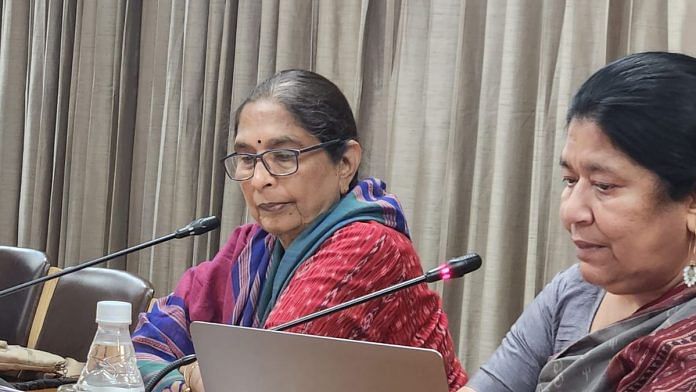New Delhi: “There was a time when marriage was never a happy occasion. Marriage meant brutal emotional and sexual violence, miscarriages for Indian women.”
A statement like that, and everybody in the room at Delhi’s India International Centre sat up and listened. That’s how women’s histories go.
The speaker was Shanta Sinha, former chief of the National Commission for Protection of Child Rights, a political science professor, and a Padma Shri and Ramon Magsaysay awardee. The audience was a few dozen historians and students. She was speaking about stories of women embedded in her grandparents’ autobiographies in a talk titled ‘Writing the Self: Women’s Questions in South India, Early Twentieth Century’.
“If you heard the story of a woman in the late 19th and early 20th century, you get the story of the country as a whole,” Shanta Sinha said.
Through three generations, she said it became apparent how families, schools, sports grounds, and streets were all sites of contestation for young girls.
Writing the self
She read from her grandfather’s published and her grandmother’s unpublished autobiographies. Her grandfather was no ordinary man. He was Mamidipudi Venkatarangaiah, who set up the political science department at Bombay University and was a Padma Shree awardee himself. But Sinha’s focus was to just glean the stories of women from his autobiography and build a history of that era.
An intergenerational narrative on the social transformation of women across a century that has been constructed from the memories of women in her family, Sinha’s talk was part of the IIC Sectoral Policy Group on History, a close-knit group of historians. In 2022, the IIC formed 13 special policy groups ranging from history to hate speech to media to agriculture and security. The goal of the history group is to bridge the gap between academia and the public.
They persuaded social scientists and historians to write personal essays detailing their own personal and intellectual journeys. Sinha’s talk is the first of a series of papers.
Three out of four of Venkatarangaiah’s sisters lived tragic lives at the hands of abusive husbands and died early from medical neglect. Sinha quoted from both her grandparents’ writings to build rich stories of the lives of the women in her family.
Then, there was one sister named Venkatamma who defied the life that was drawn out for her. Like others, she too was married at 10. Her husband died within a year.
“She was quite naughty,” Sinha said and added that the family punished her often. And when she was 15, she ran away from home. The Brahmin family assumed she had died. But she joined a Christian missionary and converted and even proselytised.
Sinha’s family was boycotted by the Brahmin community because of her conversion to Christianity. She visited the family when she was 80 years old in 1965 with a rosary in her hand. Sinha said Venkatamma was her favourite character in the autobiography. But her grandfather never forgave her for the misery she caused the family.
The grandfather resolved that his own three daughters would not face the fate of his sisters, Sinha recounted. He invested in their education.
And within a generation, change arrived. It was the heady era of the freedom movement. It was the first instance of mass political mobilisation of women in India.
One of Venkatarangaiah’s daughters Annapurna was a ‘fierce radical’. She grew up to be a Gandhian in the 1930s, joined the Sarvodaya movement, became a feminist, and worked toward the eradication of caste untouchability and tuberculosis. She set up a hostel for young Dalit girls and educated them.
Sinha recalled going to Tirupati temple with her aunt Annapurna to advocate temple entry for Dalits in 1961. She would chant “Enough is enough, move on move on,” as she ushered the young Dalit girls into the temple.
Also read:
Pursuing women’s history
Shanta Sinha herself became a scholar-activist, teaching history at the University of Hyderabad, campaigning for human rights and also working toward ending child labour in Andhra villages. She credited the early influences of her aunt on her thinking.
Her grandmother’s autobiography was rich with details about her own ambition and what she aspired for the others in her family. She was a daughter of the deputy collector and had studied up to fifth grade.
She was 16 when she decided that her husband should be a teacher and not a clerk.
“She wanted to learn music, but my grandfather said no. He taught her all the Telugu classics, he taught her English,” Sinha said. Because of her English-speaking skills, she was very popular wherever she went. She even translated Henrik Ibsen’s A Doll’s House into Telugu for the United States consulate.
“She would insist that we all read the newspaper every day, even the daughters-in-law,” Sinha recalled.
It’s been over four decades since the world woke up to pursuing women’s history as an active endeavour. History classrooms in American schools routinely ask young students to go speak to their families about historical events. “What did your grandmother do during the war?” is a popular homework. With the growth of oral history as a formal discipline, history is no longer restricted to stuffy libraries and history teachers forcing students to memorise dates. But public history is only taking shape in India now. The Oral History Association of India was formed a little over a decade ago.
The two histories of Sinha’s family were constructed differently by her grandparents, she said.
“My grandmother’s autobiography focused entirely on the family. It was more sensuous. It was not chronologically constructed,” Sinha said. “My grandfather narrated it in a social, political context in which his life changed. It had good texture of the context.”
She ended her talk with a poignant admission. “The sufferings of the women in this family made us what we are.”
(Edited by Zoya Bhatti)



